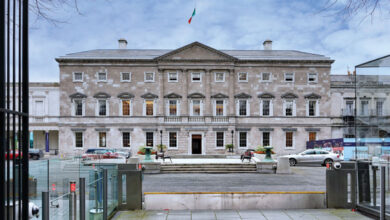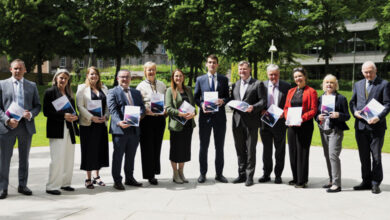apps.ie
 With over 100 software developers in Ireland now making a living developing applications (apps) for the Apple iPhone, Meadhbh Monahan speaks to two of them about why the market has become so popular and their thoughts on the future stability of this line of work.
With over 100 software developers in Ireland now making a living developing applications (apps) for the Apple iPhone, Meadhbh Monahan speaks to two of them about why the market has become so popular and their thoughts on the future stability of this line of work.
The iPhone has now become a must-have gadget since its launch in 2007, when it was named ‘invention of the year’ by Time Magazine.
Its array of applications such as internet, GPS, dictaphone, torch, spirit level and video camera has made it popular across the world.
In 2008 Apple opened an online apps store which now has over 120,000 software programmes such as games, work accessories and travel tools that can be downloaded to the phone, some for free, some for a small fee.
An app is a custom programme written to run on the iPhone. Because the iPhone consists of lots of hardware, the range of apps that can be developed is virtually endless.
Irish interest in iPhone apps has exploded in the last year and there are now over 100 Irish software developers making apps for the iPhone.
Twenty-one year old Steven Troughton-Smyth, a digital media engineering undergraduate at DCU, who lives at home in Killiney, County Dublin, is one example of the success stories that have arisen in Ireland due to the popularity of the iPhone.
From tinkering around with his Macintosh at the age of nine until he became serious about developing apps when he was in transition year, aged 16, his interest “paid off big-time” when the iPhone was introduced.
He says: “A little over a year ago this was just a hobby. Now I have a profession that I adore.”
Throughton-Smyth explains that the method of programming for the iPhone is exactly the same as programming for the Mac and a Mac is required to programme the iPhone.
Another Dublin apps developer, Dermot Daly, 39, a former director of software for a small company, left his job because of reduced orders and the economic downturn.
He had “all the necessary tools” and had “become a fan” of his iPhone. Daly quickly started to develop apps and meet with other Irish developers to discuss and develop ideas.
A group of Irish developers called X-Cake was subsequently formed and they launched their website, http://apps.ie.
The pair believe that the Irish apps market has become so popular despite the recession because of the relatively low cost of apps, which typically cost from 79 cent up to €4.99.
“At these prices apps are still very much impulse buys so are somewhat recession proof,” says Daly.
Troughton-Smyth agrees: “The iPhone is such a natural and capable device that people want to expand and personalise their own by installing apps,” he says.
“It is incredibly easy to purchase an app with a single click and the software prices are generally much lower than any traditional platform.”
Daly says that there has been a surge in iPhone apps developers in Ireland because it is easy to join the iPhone developer programme, at just €79 per year.
“As long as a developer has a Mac and iPhone (or iPod touch) and joins the programme, they can become an iPhone developer,” he sums up.
When asked whether Irish businesses could use apps to their benefit, Daly claims there are “many opportunities” for companies to provide access to their product or services via iPhone applications. He recently made this point at an Enterprise Ireland conference called ‘iPhone as an emerging enterprise platform’.
 “It’s a pity that Irish companies have been slow to react,” Daly says. “But Irish developers are filling the void. If you take a look in the app store for example, you will see many apps covering the route and timetable information for Dublin Bus, Irish Rail, and Dart already.”
“It’s a pity that Irish companies have been slow to react,” Daly says. “But Irish developers are filling the void. If you take a look in the app store for example, you will see many apps covering the route and timetable information for Dublin Bus, Irish Rail, and Dart already.”
Daly recommends that websites which have large audiences should offer these through an iPhone app.
“A good example of companies who could benefit like this are RTÉ, who could be offering video and sound clips though a dedicated app. Many other radio stations are already doing this,” Daly explains.
The Irish Independent and Irish Times are some of the newspapers that have launched their apps allowing users to read headlines and download the latest news to their phones.
“Companies who offer services to the general public should be considering apps to differentiate themselves from their competition,” says Daly.
Troughton-Smyth says the possibilities for Irish businesses are “limitless,” adding: “The iPhone is a device that is always with you in your pocket, always-connected to the internet and always knows where you are through GPS or cell-tower based positioning.”
He uses the Starbucks app as an example. “It allows you to fully browse the Starbucks menus and compose anything you’d like beforehand and then simply show your choice to the attendant instead of standing in a queue trying to choose what you’d like on the spot. This is a marketing gold-mine in that respect.”
The main issue being discussed by Irish apps developers at the moment is “marketing”.
“No matter how good an application is, if nobody knows it exists then it’s a failure,” says Throughton-Smyth.
“We are asking how we can expand our operations and raise our profiles on an international scale,” adds Daly.
He reveals that there has been some interest in Ireland from North America but Ireland has to compete with the cheaper countries in eastern Europe and India.
“Unfortunately many of the professional apps developers are small companies, which fall out of Enterprise Ireland’s guidelines for HPSU [high potential start-up], making it difficult to apply for funding to showcase us on an international basis,” Daly continues.
“Our argument is that the world is changing like we’ve never seen before and it is possible for a company to generate large incomes without a very large staff base. Twitter is a prime example of this. It is now one of the most popular services on the internet, whilst still being run by a handful of people.”
Looking towards the future, both developers are aware that gadgets are constantly being replaced and updated with newer and better versions.
Throughton-Smyth believes that because “in just over a year” the iPhone has “blown wide open the gates of downloadable mobile software,” it will “continue to innovate and break ground in new ways we cannot imagine possible today.”
 He predicts that mobile software in general will “continue to evolve rapidly either breaking ground by itself or by following Apple’s lead.”
He predicts that mobile software in general will “continue to evolve rapidly either breaking ground by itself or by following Apple’s lead.”
The developer concludes: “I don’t think the market for mobile software will go away or vanish overnight, but it will become more an expected extension of our lives just like the software we use on the comp
uter every day.”
Daly admits that “the apps market is definitely becoming very crowded and the idea of someone making an overnight success is becoming more remote.”
Potential competitors to the iPhone will arrive on the scene soon, he forsees.
“I believe the iPhone will remain dominant for the foreseeable future but there are a number of excellent android [a competing product] handsets coming on the market next year,” he explains.
Daly continues: “There are many industry pundits suggesting that the iPhone crown will be toppled. I don’t believe this will happen just yet, I think the android handsets may well steal second place, to the detriment of Nokia, Sony Ericsson and RIM (Blackberry).”
In light of this Daly believes that Apple “will not be resting on their laurels” and will continue to release new features that will “wow” their customers.





